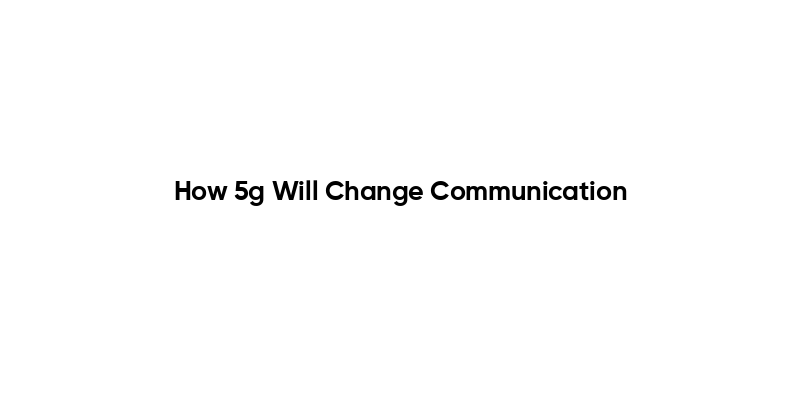The advent of 5G technology marks a significant milestone in the evolution of communication. As we delve into the topic of how 5G will change communication, it becomes clear that this next-generation network will not only enhance mobile connectivity but also redefine the way we interact with the world around us. With faster speeds, lower latency, and the ability to connect a multitude of devices simultaneously, 5G is set to transform industries and everyday life in unprecedented ways.
In this article, we will explore the various dimensions of 5G technology and its implications for communication. You will learn about the key features that distinguish 5G from its predecessors, such as its impact on Internet of Things (IoT) devices, smart cities, and telemedicine. Additionally, we will discuss how businesses can leverage 5G to improve operational efficiency and customer engagement, paving the way for innovative solutions that were previously unimaginable.
As we navigate through the exciting possibilities that 5G brings, we invite you to join us on this journey of discovery. By understanding how 5G will change communication, you will gain insights into the future of connectivity and the transformative effects it will have on our daily lives. Stay with us as we uncover the potential of this groundbreaking technology and what it means for you.
Enhanced Mobile Broadband
The introduction of 5G technology promises to revolutionize mobile broadband services. With significantly higher data rates, users can expect download speeds that are up to 100 times faster than 4G. This enhancement will allow for seamless streaming of high-definition videos, faster downloads, and improved overall user experience. As a result, applications that require high bandwidth, such as virtual reality (VR) and augmented reality (AR), will become more accessible and practical for everyday use.
Moreover, the increased capacity of 5G networks will support a larger number of connected devices simultaneously. This is particularly important in urban areas where network congestion is common. With 5G, users will experience less latency and more reliable connections, making mobile communication more efficient and enjoyable.
Internet of Things (IoT) Integration
5G technology is set to play a crucial role in the expansion of the Internet of Things (IoT). With its ability to connect millions of devices with minimal latency, 5G will enable smart cities, smart homes, and various industrial applications. For instance, smart sensors in urban infrastructure can communicate in real-time, optimizing traffic flow and reducing energy consumption.
This integration will also enhance communication between devices, allowing for more sophisticated automation and data analysis. As a result, businesses can leverage IoT solutions to improve operational efficiency and customer experiences. The potential for innovation in sectors such as healthcare, agriculture, and manufacturing is immense, as 5G facilitates the development of new applications and services.
Improved Communication in Remote Areas
One of the most significant impacts of 5G technology will be its ability to improve communication in remote and underserved areas. Traditional broadband services often struggle to reach these locations, leaving residents with limited connectivity options. 5G’s advanced infrastructure can provide high-speed internet access to rural communities, bridging the digital divide.
This enhanced connectivity will empower individuals and businesses in remote areas, enabling them to access online education, telehealth services, and e-commerce opportunities. As a result, 5G can contribute to economic growth and social development in regions that have historically been marginalized in terms of technology access.
Revolutionizing Telecommunication Services
5G technology is poised to transform telecommunication services by enabling new business models and enhancing existing ones. With its high-speed capabilities, telecom providers can offer innovative services such as ultra-reliable low-latency communication (URLLC) for mission-critical applications. This is particularly relevant for industries like healthcare, where real-time data transmission can be life-saving.
Additionally, 5G will facilitate the development of new applications that rely on real-time communication, such as remote surgery and autonomous vehicles. As telecom companies adapt to this new landscape, consumers can expect more competitive pricing and improved service offerings, ultimately benefiting the end-user.
Security and Privacy Challenges
While 5G technology brings numerous benefits, it also introduces new security and privacy challenges. The increased number of connected devices and the complexity of the network can create vulnerabilities that malicious actors may exploit. Ensuring the security of data transmitted over 5G networks will be paramount for both individuals and organizations.
Telecom providers and policymakers must work together to establish robust security protocols and regulations to protect users’ privacy. This includes implementing encryption, secure authentication methods, and continuous monitoring of network traffic. As 5G continues to evolve, addressing these challenges will be essential to maintain user trust and ensure the safe adoption of this transformative technology.
| Aspect | Description |
|---|---|
| Speed | 5G technology offers significantly higher data transfer speeds compared to 4G, enabling faster downloads and uploads, which enhances user experience in streaming and gaming. |
| Latency | 5G reduces latency to as low as 1 millisecond, allowing for real-time communication and interactions, which is crucial for applications like remote surgery and autonomous vehicles. |
| Capacity | 5G networks can support a larger number of devices simultaneously, making it ideal for densely populated areas and the growing Internet of Things (IoT) ecosystem. |
| Reliability | With improved reliability, 5G ensures consistent connectivity, which is essential for critical applications such as emergency services and industrial automation. |
| New Applications | 5G will enable new applications and services, including augmented reality (AR), virtual reality (VR), and smart city technologies, transforming how we interact with the world. |
| Global Connectivity | 5G aims to provide better connectivity in rural and underserved areas, bridging the digital divide and promoting equal access to information and services. |



